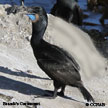Field Guide for all the Birds of North America
Cormorants
Cormorans
Phalacrocoracidae
Information, images and range maps on over 1,000 birds of North America, including sub-species, vagrants, introduced birds and possibilities
North American Bird Search Box
There are six types of cormorants native to North America. The most abundant and widespread is the Double-crested Cormorant, which can be found throughout the continent in freshwater and in seawater along the coasts into Northern Quebec and up into the far reaches of Alaska.
The Great Cormorant lives along the shores of the Atlantic Ocean from Labrador down to the tip of Florida.
The Pelagic Cormorant and the Brandt's Cormorant can be seen along North American coastlines. The Red-faced Cormorant lives in the southern regions of Alaska out into the Aleutian Islands. The most southern is the Neotropic Cormorant and is found along the southeast areas of Texas down into Mexico.

The cormorants are excellent at catching fish which is their main diet. These birds have long serrated bills with the shape of a hook at the end perfect for catching and holding their prey. These birds are also excellent swimmers with strong stubby legs. The cormorant has the ability to submerge its body into the water where all that is seen is its head.
Reference to Other Bird Site:
ABA - American Birding Association This site represents an organization that maintains official records of all birds species that have been proven to have been seen inside the perimeters of the North American Continent and the surrounding bodies of water. Regular revised versions are posted to keep the bird list current at all times. This is the list used by all serious birders over their lifetime. You may be aware of the movie called the "Big Year". It was with this list that all the competing birders used in an attempt to set a new record as to how many bird species that could be seen by an individual birder in one calendar year.





